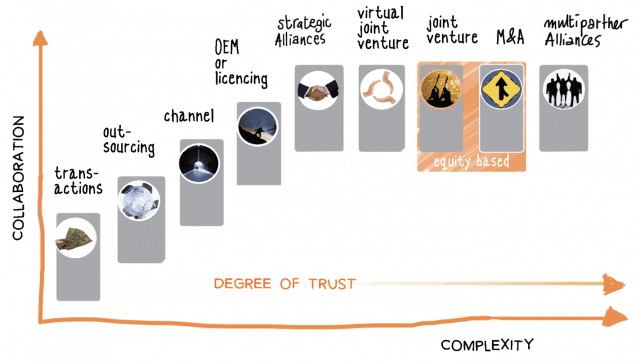We have seen what strategic alliances are and why one would partner in strategic alliances. In this article, we’ll have a look at the collaborative business spectrum.
It appears that the term strategic alliance has a different meaning to people. In a recent roundtable of alliance people, we started off with the question “what do alliances mean for your company?”
The attendees had different viewpoints. Ranging from marketing alliances, to go to market alliances, to development alliances and including for one to an alliance consortium. In all cases the alliances were shaped to be stronger together than one of the companies can be alone. Not necessarily this meant that the participating companies in the round table could not have done it alone, however teaming up with others to fulfill the goal of the alliance made the effort more effective.

The collaborative business spectrum can be visualized by the degree of collaboration and integration or complexity. On the left-hand side transactional relationships and on the right-hand side merger & acquisitions. In between is the area often covered by the term alliance. Within this collaborative business spectrum, we see several forms of partnership, divided by the degree of collaboration and integration.
Outsourcing on the most left side of the spectrum can be seen as examples of an efficiency alliance; your partner is better equipped to do the task for you, for a better price and with better service. The relationship is strategic, but it is not a pure alliance where both parties are contributing. In general, it is outsourcing of a task and the degree of collaboration is low.
In a channel relation, the alliance is created to bring your products via a channel partner to the market. As such it is an example of a market development alliance. Depending on the type of product, the degree of collaboration and integration can be higher. A classical example are the European car dealerships. A dealer will in general only represent one brand and is as such quite depended. When ordering a car for a customer that car is often customized with add-ons for that specific customer which requires collaboration and integration with the car manufacturer to deliver the right product to the customer. Also, the Value Added Resellers (VAR) in IT are good examples of channel relations.
In licensing relations, your brand will be licensed out to another party. That organization will add value to the brand and bring it to the market under your brand. Reckitt Benckiser licensed their Air Wick brand to Winplus to develop a range of car air fresheners for the North American market. In fact, a market development alliance, allowing the Air Wick brand to enter the new market of car air fresheners with the specific knowledge of Winplus. In OEM relationships your company is the opposite of licensing; another company will manufacture products that you will use as (part of) your product, with your brand. Given the importance of the licensing or OEM relation for your brand, integration and collaboration will be on a higher level than with pure transactional supplier relationships.
Strategic alliances are based on an agreement to collaborate. The Senseo coffeemaker is a good example of a strategic alliance, both Philips, and Sara Lee/Douwe Egberts (now JDE Peets) have their responsibility for developments of their elements in the joint offering. There is no exchange of equity between the two companies, but the level of collaboration is high and needs to be high to keep both organizations aligned on the same path of product development.
Within a virtual joint venture, the organizations work even closer together while remaining independent companies. The KLM -Air France – Delta alliance is an example of a virtual joint venture. All the parties bring in aircraft, staff and support operations with a tight integration of operations. Ownership of the assets remains with the partner companies, and revenues will be split between the two companies.
Joint ventures are separate independent companies where two or more companies work together and hold the shares. In general, the joining of forces is with the focus to make the whole larger than the sum of the two parts. In some cases, joint ventures are also more of a defensive nature and formed to divest in products or product lines. Examples of joint ventures are Emgo, a long-standing joint venture since 1966 between Osram and Philips. It was originally established to produce incandescent lamps and now has its focus on the creation of innovative products in lighting. Another example is Sony-Ericsson, between 2001 and 2012 a joint venture of Sony and Ericsson with the aim to produce mobile phones.
[…] the amount collaboration and complexity involved. The breakdown of each can be found in his post The Alliance Spectrum, or by downloading his e-book on Successful Partnerships & Strategic […]
[…] on the amount collaboration and complexity involved. The breakdown of each can be found in his post The Alliance Spectrum, or by downloading his e-book on Successful Partnerships & Strategic […]
[…] must be more kind of alliances than just strategic alliances. If you have read my post about the alliance spectrum, you have seen many more flavors of business partnerships. There are also companies that use terms […]
[…] alliances mean for your company?” The attendees had different viewpoints covering the complete spectrum, ranging from marketing alliances, go-to-market alliances, development alliances, and including for […]
[…] have read what alliances are, why to partner, what’s in the alliance spectrum and that alliances can fail. Especially after the last article the question may rise on how to […]
[…] alliance can be characterized as a channel alliance. AkzoNobel Global Personal Care will be the channel to bring the products of Corn Products […]